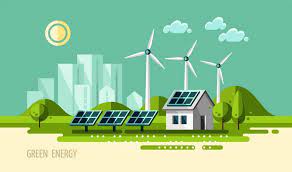Geothermal and wind energy
Courtesy : ww1.cugb.edu.cn/
The overdevelopment and consumption of fossil energy
resources (FER) have caused environmental and ecological problems that impacts our daily lives. Continued dependency on fossil
fuels may increase the rate of global warming with disastrous
consequences [1]. When the Intergovernmental Panel on Climate
Change (IPCC) issued its 2007 assessment [2], it recommended to
keep atmospheric greenhouse gases below 450 ppm in order to
keep the temperature rise under a 2 1C target [3]. It seems that this
is a big challenge. In the coming decades, global environmental
issues will significantly affect patterns of energy use around the
world. Any future efforts to limit carbon emissions are likely to
alter the composition of total energy-related carbon emissions by
energy sources. Air pollution is becoming an important environmental concern in some of the developing countries. In this
regard, renewable and clean energy resources (RCER) are becoming attractive for sustainable energy development and environmental pollution mitigation in these countries [4–12].
Renewable and Sustainable Energy Reviews 42 (2015) 1464–1474
Not only do future energy technologies need to be clean and
renewable, but they also need to be robust, especially in some
developing countries such as China [13,14]. The recent heavy fog
enveloping a large swathe of Eastern and Central China is a stark
example. There was neither sunshine (no solar energy) nor wind
(no wind turbine rotating). Furthermore, Beijing was hit 4 times by
heavy haze and fog within one month in January 2013. Hundreds
of flights were cancelled and highways were closed. The Beijing
meteorological observatory issued a yellow alert (the highest level
alert) for heavy fog on January 22, 2013.
The existing energy systems in many countries are not sustainable due to the increasing energy demand triggered by population
expansion and economic growth, as well as short-and long-term
uncertainty in connection with the availability of resources. A new
energy structure with consumption-rationing and high efficiency
needs to be achieved simultaneously. More emphasis on the use of
renewable and clean energy sources is important to shift the
structure of our energy system towards sustainability [15].
Ming et al. [16] analyzed the physical and technical potential of
several disrupting technologies that could combat climate change
by enhancing outgoing long wave radiation and cooling down the
Earth. The technologies proposed were power-generating systems
that were able to transfer heat from the Earth’s surface to the
upper layers of the troposphere and ultimately to space. The
economic potential of these technologies is clear, as they simultaneously produce renewable energy (RE), thus reducing future
greenhouse gases emissions, and also are more socially acceptable
compared to geoengineering.
One of the currently practical solutions to the problems caused
by FER may be the large scale utilization of RE. In recent decade or
so, RER have grown fast, especially the solar and wind energies
although the utilization of RE is still far from its potential at a
global scale [17]. The relatively fast growth of using RER might be
because of their many benefits: (1) reducing the emission of CO2
as well as other greenhouse gases and improving environment;
(2) assisting with energy independence in many countries without
enough fossil energy resources; (3) diversifying resources of
energy production and improving the structure of the existing
energetic systems; (4) contributing to a sustainable development;
(5) increasing local labor employment; (6) reducing risks and
disasters (for example, explosions of natural gas pipes) caused by
using FER.
As summarized in Renewables 2014: Global Status Report [17],
hydropower rose by 4% to approximately 1000 gigawatts (GW),
while other renewables collectively grew nearly 17% to an estimated 560 GW. Globally, hydropower and solar photovoltaics (PV)
each accounted for about one-third of renewable power capacity
added in 2013, followed closely by wind power (29%). For the first
time, more solar PV than wind power capacity was added worldwide. By the end of 2013, renewables comprised an estimated
26.4% of the world’s power generating capacity. Unfortunately, the
contribution of geothermal power (GP) is very small.
It is known that geothermal energy has many advantages over
solar and wind systems. These advantages include: (1) unaffected
by weather; (2) it is a base-load power; (3) it is stable and has high
capacity factor over 90% in many cases; (4) it requires less land and
has less ecological effect; (5) it has high thermal efficiency. The
total installed capacity of geothermal electricity, however, is much
less than those of solar and wind energies.
Geothermal energy has two types of utilizations: direct use and
power (electricity) generation. Direct use includes space heating
(for example, greenhouse heating, snow melting, plant and food
heating), cooling, and other applications using low enthalpy
geothermal energy. Despite the direct use, including the use of
geothermal heat pumps, of geothermal energy has developed
rapidly during the past many years [18–23], only the geothermal
power generation has been considered to compare with hydropower, solar and wind energies in this paper.
Trying to find the reason for the stagnant growth in geothermal
power generation, Kubota et al. [15] conducted semi-structured
interviews with 26 stakeholders including developers, hot spring
inn managers, and local government officials. The results showed
that the societal acceptance of geothermal power by local stakeholders was the fundamental barrier as it affected almost all other
barriers, such as financial, technical, and political risks. They
thought that a key reason for opposition was identified as
uncertainty about the reversibility and predictability of the
adverse effects on hot springs and other underground structures
by geothermal power production and reinjection of hot water from
reservoirs.





